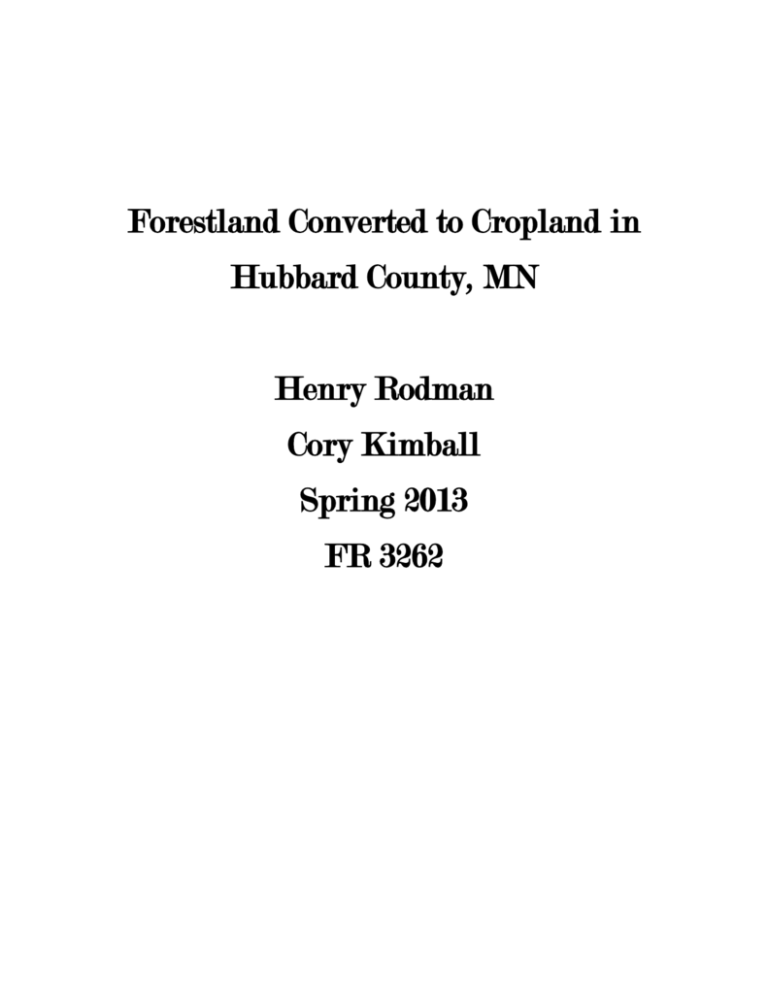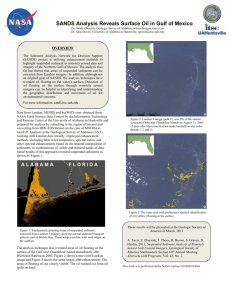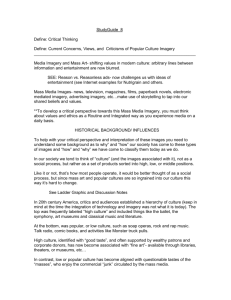Report
advertisement

Forestland Converted to Cropland in Hubbard County, MN Henry Rodman Cory Kimball Spring 2013 FR 3262 Project Description In this study we have conducted a survey on the transition of forest land to agricultural land in Hubbard County, Minnesota. Hubbard County covers 639,360 acres in North Central Minnesota and is made up of 28 townships and 1008 sections. Over the last several years, there has been a trend of increased agricultural practices on the landscape – mostly in the form of forests converted to potato fields. Hubbard County has been known for its potato crops and this seems to be the main source of land conversion according to the county Land Department, possibly as a result of the expiration of many Conservation Reserve Program (CRP) easements. In Minnesota alone, there was a declined enrollment in CRP of 43,000 acres between 2011 and 2012 (Haroldson 2012). Using image classification software and Landsat imagery we aim to quantify the amount of land that has been converted from forestland to cropland in recent years. Remote sensing, in combination with field observations provides a great toolset for quantifying the amount of deforestation in the last several years. Deforestation is often associated with slash and burn agriculture practices in the Amazon rainforest, but evidence suggests that it is a growing problem in northwest Minnesota. With access to orthorectified satellite imagery and image processing software, the task of measuring changes in land-use becomes quite streamlined. We aim to classify land-use in four images of Hubbard County and create historical comparisons between these images and previously developed land-cover maps. By creating maps that show change from year to year and comparing land-use between several years, we can make inferences about the severity and rate of deforestation in Hubbard County. Materials, Tools, and Concepts: We used 7-band Landsat imagery collected in the summer months between 2000 and 2009 and accessed through the GLOVIS browser at the USGS website. In addition, we had on-the-ground photos to provide some context for the discussion on deforestation. These photos were taken in April of 2013 by Cory Kimball in Park Rapids, MN. We also had personal conversations with individuals at the Hubbard Co. Figure 1: Potato Field near Park Rapids, MN Land Department that have provided some perspective on land-use changes. Digital image classification is a very powerful tool in land-use classification efforts so we made use of our training and expertise in these processes to produce estimates of land-use. Supervised classifications of the imagery were carried out using ERDAS Imagine 2011 (ERDAS) and shapefile manipulation was performed in ArcGIS 10.1. The combination of these two software packages gave us the tools we needed to make estimates of land-use change over a decadelong period. Procedures 1. Imagery containing the study area was acquired from the USGS, accessed from the GLOVIS browser. a. Imagery was captured in either July or August, many of the images had either significant amounts of clouds, or (if the image was taken from Landsat 7) there were streaks that made it unusable b. The best combination of images was included July 2000 and July 2009 2. Landsat GEOTIFFs were stacked in ERDAS and saved as ‘.img’ files 3. Imagery for each year was reprojected into the NAD1983 Zone 15N datum 4. Each image was clipped in ERDAS to the study area, Hubbard County 5. Training samples for a supervised classification were created for the 2000 and 2009 imagery in an AOI and entered using the signature editor. a. Classes included: Forest, clearcut forest, wetlands, developed Figure 2: Clipped image (commercial/residential buildings, roads), agriculture, clouds, shadows. b. 5-20 training samples for each class (more for forest and agriculture than the others). 6. Supervised classification was performed and effectively similar classes were combined. a. Forest: forest + clearcut forest, non-forest: developed + agriculture, clouds/shadows: clouds + shadows 7. Histograms of each classified image were compared to assess percent change in land use a. Proportion of total pixels classified was calculated for each land-use classification 8. Accuracy assessment of the classification was carried out in ERDAS using the Landsat imagery as reference data with a stratified random sampling of points to be compared. Results: The results of the supervised classifications did not reflect any significant change in land-use between 2000 and 2009. There were small fluctuations in percent land cover of forest, agriculture and wetlands but the results of the accuracy assessments suggest that there was no significant observable difference between the classified images from the two years. It is possible that the slight increase in cloud cover in 2009 contributed to the muted differences in other land-use classes. Based on field observations and trends in CRP enrollment in Minnesota, it seems unlikely that there was no significant deforestation between 2000 and 2009. The results of this comparison are likely skewed by the inaccuracy of the supervised classifications. Discussion: Although we were unable to produce any ground-breaking results, this endeavor was a good introduction to the process of managing imagery and gathering useful information from amazingly low-cost sources. The final result was largely a product of trial-and-error and the eventual choice of Landsat data proved to make the project a manageable task. The 1-m resolution NAIP data was conveniently available as one Hubbard County-wide image, but the file was so gargantuan (700 MB zipped) that image classification processes would drag on for hours, and produce no results. After struggling with those files, stacking the Landsat GEOTIFFs was a welcome break from the cumbersome processes associated with the NAIP imagery, even at the cost of decreased resolution. When we settled on Landsat imagery, the challenge then became sifting through the vast amounts of data to find images that were not corrupted by cloud cover or Landsat 7 lines. We emerged from this step with two relatively cloud=free images that were separated by an appropriate amount of time (2000, 2009). We hoped that that window would be Figure 3: Excessive cloud-cover, courtesy of the USGS wide enough to make any change in land use apparent at 30 meter spatial resolution. The next challenge was creating accurate, valuable training samples for the supervised classification. This was difficult because there was a striking similarity between recently harvested forest and some agricultural fields – the color of emergent vegetation on recently harvested forest are very similar to many crop fields. Additionally, wetlands appeared had a similar color signature to some crop fields. The ambiguity between these classes was probably the reason our results did not reflect the trend of increasing deforestation, so it seems that imagery from late spring, early summer, or early fall would have been better choices for classification purposes. Another direction we could have taken in distinguishing forest from agricultural fields was the use of LiDAR data – it is available statewide, but historical comparison between LiDAR data sets may not have been possible because the statewide dataset is a very recent development. The accuracy assessment reflected the difficulty of creating adequately distinct training samples for each class – the 2000 classification yielded an overall accuracy of 72%, while the 2009 classification yielded 78.67%. Many of the classification errors occurred around the edges of clouds, between wetlands and agricultural fields, and in recently harvested areas. The questionable accuracy of the classifications is what led us to downplay the significance of our results regarding land-use change in Hubbard County – however, it would not require a large expansion of time or resources to accomplish a more meaningful study. By following our procedure and using imagery from a different time of year, a subsequent study could reveal the true amount of deforestation in Hubbard County. Appendix Imagery: Figure 5: Landsat Imagery from July 2000, courtesy of the USGS Figure 4: Landsat Imagery from July 2009, courtesy of the USGS Classifications Figure 7: 2000 Classification Figure 6: 2009 Classification Accuracy Assessment References 1. DNR Data Deli. Shapefile Database Accessed 3/2013. 2. FR 3262 Lab Manuals. Accessed between 1/2013 and 5/2013. Dept. of Forest Resources, University of Minnesota. 3. Haraldson, Kurt J., 2012 Minnesota August Roadside Survey. September 2012. Minnesota Department of Natural Resources. 4. Lomeier, Mark. Personal Communication April 5, 2013 5. Trappe, Kevin. Personal Communication April 5, 2013 6. USGS Eros Data Center: GLOVIS Browser, Accessed April 15, 2013







